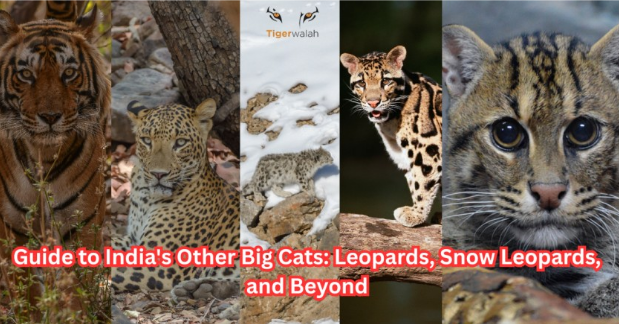As someone who has dedicated his life to India’s wild places, I can tell you that there’s a world of wonder beyond the tiger. While the striped predator is the star, the real story of Indian big cats is one of incredible diversity, adaptation, and silent survival. I’ve spent countless hours in the field, tracking, observing, and learning about these magnificent animals. Let me share my knowledge with you, section by section, like turning the pages of a well-worn field guide.
Safari Plan: Consider a trusted tour operator like Tigerwalah for a hassle-free experience covering everything from permits to on-ground support.
The Indian Leopard (Panthera pardus fusca)
- My Experience: I’ve seen leopards in more habitats than I can count. Their ability to blend into the landscape is uncanny. I once spent an entire morning looking at a rock face in Jawai, convinced there were none, only for a cat to emerge from what I thought was just a shadow. It’s a humbling experience that reminds you how truly wild they are.
- Facts and Details: The Indian Leopard is a subspecies of the leopard, which is the most widely distributed big cat in the world. They are smaller than tigers, with adult males weighing around 50-77 kg and females 29-34 kg. Their most iconic feature is their coat of rosettes, which are unique to each individual—like a human fingerprint. They are incredibly powerful, known for their ability to haul kills, even those larger than themselves, up into the safety of a tree to protect them from other predators like hyenas and tigers. Leopards are solitary and mostly nocturnal, though in some areas, like Jawai, Jhalana they have become more diurnal due to a lack of other predators. They have an impressive range of vocalisations, from guttural growls to a unique rasping sound that is often mistaken for a cough.
- Population & Conservation: According to the 2022 census, India has an estimated 13,874 leopards, a promising increase from previous years. However, this number doesn’t tell the full story. Over 65% of this population lives outside protected areas, leading to frequent and often tragic human-leopard conflict. This is the biggest threat they face, along with poaching for their skins and body parts. The species is listed as “Vulnerable” by the IUCN.
- Where to See Them: For an unforgettable leopard safari in India, my top recommendation is the Jawai-Bera region of Rajasthan. The unique geological formations and the cats’ remarkable coexistence with the local Rabari community make it a one-of-a-kind experience. Other good locations include Jhalana Leopard Conservancy in Jaipur and the tiger reserves of central and southern India, where a keen eye can spot them on the periphery of the tiger’s domain.
The Snow Leopard (Panthera uncia)
- My Experience: I’ve had the fortnue of seeing snow leopards on multiple occasions including – snow leopard on kill, snow leopard with cubs and snow leopard mating and each one has been a spiritual encounter. To trek into their high-altitude home in the Himalayas is to enter a world of stark beauty and profound silence. They truly earn their title, the “Ghost of the Mountains.”
- Facts and Details: The snow leopard is a master of camouflage and is perfectly adapted for its frigid environment. They have a thick, smoky-grey coat covered in large, irregular rosettes. Their large paws act as natural snowshoes, and their incredibly long, thick tail—sometimes as long as their body—is used for balance on steep slopes and for wrapping around themselves for warmth. Unlike other big cats, snow leopards cannot roar due to the absence of a fully ossified hyoid bone. Their primary prey consists of mountain ungulates like the Blue Sheep (Bharal) and the Siberian Ibex.
- Population & Conservation: The first official Snow Leopard Population Assessment in India (SPAI) in 2024 estimated the population at 718 individuals. This marks a crucial step in their conservation. However, the species is still listed as “Vulnerable.” Their habitat is shrinking due to climate change and human encroachment. Poaching and retaliatory killings for livestock depredation remain serious threats.
- Where to See Them: The quest to see a snow leopard in India is an expedition, not a safari; it is a snow leopard expedition. The best place is Hemis National Park in Ladakh and Spiti Valley Region in Himachal Pradesh during the winter months when the cats descend to lower elevations to find food. This is an experience for those who are physically fit and willing to endure challenging conditions for a fleeting glimpse of one of the world’s most elusive animals.
The Asiatic Lion (Panthera leo persica)
- My Experience: There’s nothing quite like the feeling of watching a pride of lions. To see them interact, to see the females work together to hunt, and to hear their roar echo through the Gir forest is to witness a living piece of history. It’s a poignant reminder that this magnificent species once roamed far beyond these forests.
- Facts and Details: The Asiatic Lion is a subspecies of the lion, now confined to a single wild population in Gujarat. They are slightly smaller than their African counterparts, with adult males weighing around 160-190 kg and females 110-120 kg. A key identifying feature is the prominent longitudinal skin fold on their belly, which is rarely seen in African lions. Another difference is their smaller, less dense mane, which leaves their ears visible. Unlike the large prides of Africa, Asiatic lion prides are smaller and more fluid, with males and females often occupying separate prides and only associating for short periods for mating.
- Population & Conservation: The conservation story of the Asiatic lion is one of India’s greatest successes. From a population of fewer than 50 in the early 20th century, the 2020 census counted 674 lions. More recent unofficial counts suggest the population has grown to nearly 900. Despite this, the species is “Endangered” on the IUCN Red List because its entire population is concentrated in one small area, making it highly susceptible to a disease outbreak or a natural disaster.
- Where to See Them: The only place in the world for an Asiatic lion safari is Gir National Park and Wildlife Sanctuary. This area and the surrounding satellite habitats are a must-visit for any serious wildlife lover.
Other Felines of India
- My Experience: It’s the smaller cats that truly test a naturalist’s patience and knowledge. They are the unseen players of the forest, often blending into the undergrowth. I’ve been fortunate enough to see a fishing cat in a wetland in Odisha and a clouded leopard in the dense jungles of the Northeast—moments that required luck and a deep understanding of their unique behaviours.
- Facts and Details:
Clouded Leopard (Neofelis nebulosa): A mysterious and ancient species, considered a link between big and small cats. It has a beautiful coat with “cloud-like” blotches. It is a phenomenal climber and is often called a “modern-day sabre-tooth” due to its disproportionately long canine teeth. It is classified as “Vulnerable” and inhabits the dense forests of Northeast India.
Fishing Cat (Prionailurus viverrinus): This medium-sized cat is a master of the wetlands. It has partially webbed feet and a stocky build, allowing it to swim and dive to catch its primary prey: fish. It is “Vulnerable” and found in coastal wetlands, mangroves, and riverine habitats.
Jungle Cat (Felis chaus): One of the most common wild cats in India. Despite its name, it prefers grasslands and wetlands to dense forests. It is highly adaptable and primarily preys on rodents. It’s classified as “Least Concern,” a testament to its resilience in the face of human-dominated landscapes.
To truly understand wildlife in India, you must look beyond the tiger. It’s in the stealth of the leopard, the ghostly presence of the snow leopard, and the quiet resilience of the smaller felines that the heart of the Indian wilderness truly beats.






























